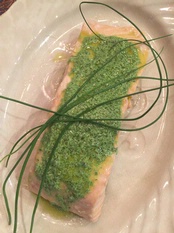 and with parsley and cilantro usually the star ingredients, chimichurri is an uncomplicated and refreshing sauce that is traditionally served with grilled meats. Italian salsa verde, typically redolent of parsley, garlic, vinegar, olive oil, and sometimes capers and anchovies, can accompany fish, roasted meats, and grilled vegetables. Mexican salsa verde uses tomatillos as its base. Since we had a lovely fillet of salmon in the fridge waiting to be poached, we decided to make a French-inspired sauce verte to go with it. Because the French version of a green sauce is generally based on mayonnaise, it tends to have a uniquely rich texture and complex flavors that, as we discovered, beautifully echo The salmon’s own richness.
and with parsley and cilantro usually the star ingredients, chimichurri is an uncomplicated and refreshing sauce that is traditionally served with grilled meats. Italian salsa verde, typically redolent of parsley, garlic, vinegar, olive oil, and sometimes capers and anchovies, can accompany fish, roasted meats, and grilled vegetables. Mexican salsa verde uses tomatillos as its base. Since we had a lovely fillet of salmon in the fridge waiting to be poached, we decided to make a French-inspired sauce verte to go with it. Because the French version of a green sauce is generally based on mayonnaise, it tends to have a uniquely rich texture and complex flavors that, as we discovered, beautifully echo The salmon’s own richness.
More recipes and wine pairings: Wine With…
|
Selection
|
Approx. Price |
Comments |
|
Susana Balbo, Valle de Uco, Mendoza (Argentina) Torrontes “Signature Barrel Fermented” 2014 (Imported by Folio Fine Wine Partners)
|
$24 |
The idea of this wine frightened us. Intensely aromatic Torrontes fermented in wood? Wouldn’t the barrels obliterate the grape’s charm? Well, no, not at all. They gave the wine added depth on the palate without imparting excessive flavors of vanilla or char. The reality of the wine thus delighted us. It served as a reminder that intellectualizing is no substitute for actually tasting.
|
|
Patient Cottat Sancerre (France) “Anciennes Vignes” 2015 (Imported by Vineyard Brands)
|
$28 |
We were pretty confident that this wine, made with 100% Sauvignon Blanc, would pair well with the salmon, and indeed it did. The grape’s natural herbal qualities meshed effortlessly with the sauce verte.
|
|
Donnafugata Sicily (Italy) Zibibbo “Lighea” 2015 (Imported by Folio Fine Wine Partners)
|
$22 |
“Zibibbo” is the Sicilian name for Muscat of Alexandria, an ancient variety with a sweet perfume and succulent flavors. When paired with our sauced salmon, “Lighea” provided a contrast of aroma and flavor. It was slightly off-dry but focused, and more than held its own.
|
|
Nals Margreid, Alto Adige (Italy) Pinot Grigio “Punggl” 2015(Imported by The Country Vintner)
|
$20 |
Unlike most northern Italian Pinot Grigios which often taste tart but non-descript, this wine offers a panoply of enticing citrus and mineral-tinged flavors. Though a tad too light for this dish, it tasted so good that we simply had to include it among our recommendations.
|
|
Stinson Vineyards. Monticello (Virginia) Sauvignon Blanc 2015
|
$24 |
Clean, crisp, and downright fun to drink, this Sauvignon augments its bold citrus flavors with echoes of melons and figs. Its appeal comes purely from its abundant fruit flavors, all supported by a firm backbone of acidity that cut right through the richness of the poached fish.
|
